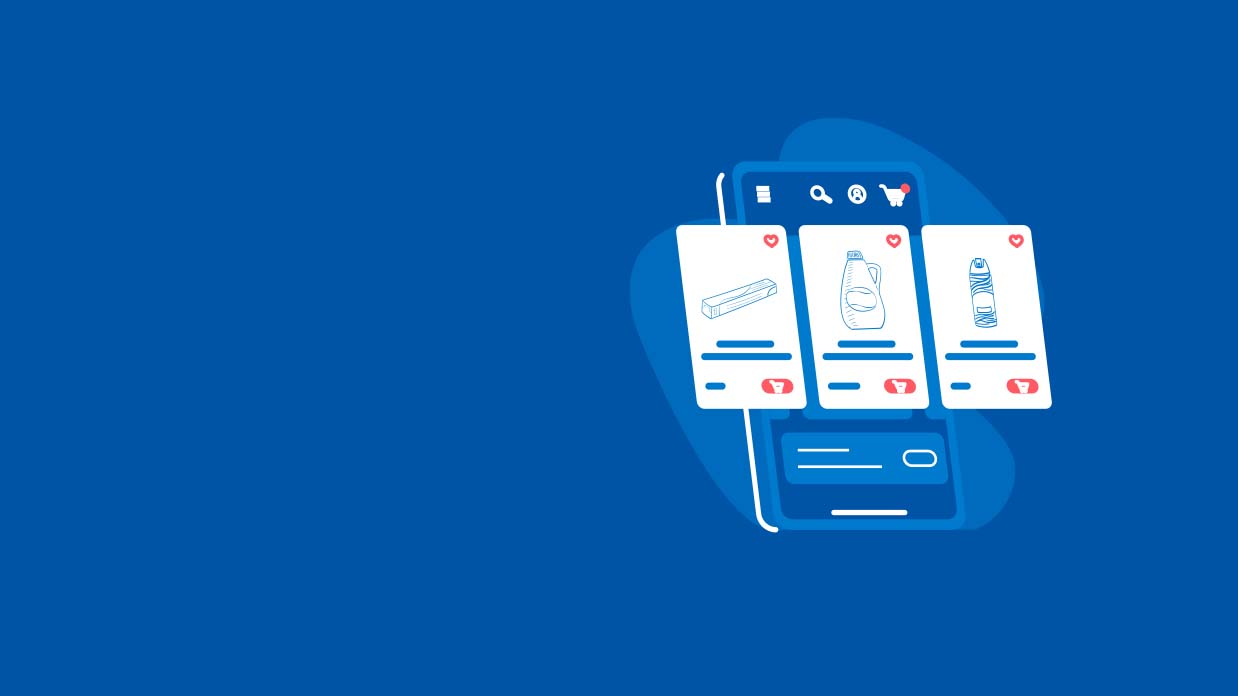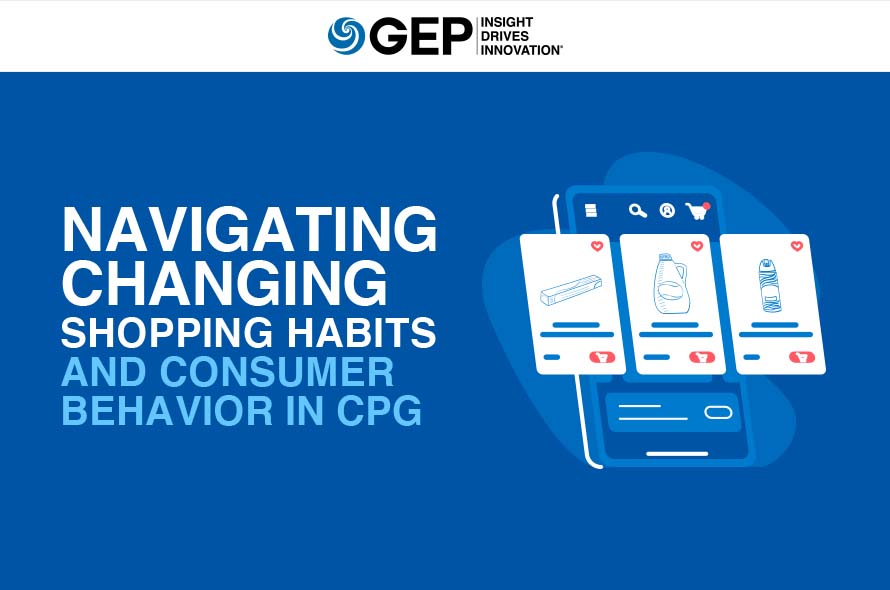Have shopping habits changed for good or are consumers returning to pre-pandemic buying patterns? Are some trends here to stay?
CPG companies need to anticipate buying behavior to take informed supply chain and procurement decisions and align supply with demand.
A new GEP Analysis — Navigating Changing Shopping Habits and Consumer Behavior in CPG — examines shopping trends in the U.S. and forecasts demand in key categories. It also looks at the functioning of global supply chains amid COVID-19 surges, and their impact on the U.S. CPG industry.
What’s Inside:
- Trends and forecasts for top CPG categories
- Travel revival and its effect on CPG
- The unpredictability of global supply chains
This paper by GEP’s CPG experts is an essential read for supply chain and procurement executives who want to balance inventory and demand and create a competitive advantage for their organizations.
Shopping habits in the U.S. changed significantly during the pandemic as consumers adopted new lifestyles and routines. But are these habits that were formed in 2020 permanent, or will people revert to pre-pandemic behavior?
According to the Centers for Disease Control and Prevention’s COVID Data Tracker, 70% of the U.S. population over age 18 has received at least one vaccine as of August 4, 2021; 60% over age 18 are fully vaccinated.1 Although vaccinations have been slower than planned, these figures are encouraging and are influencing CPG supply chain planning.
Being able to anticipate consumer behaviors and trends will help CPG companies prepare their supply chains to optimally align supply with demand. In this paper, GEP experts examine consumer lifestyle changes and purchasing habits, international supply chains amid COVID-19 surges, and how informed supply chain decisions can create a competitive advantage for CPG companies. They also discuss key CPG categories that are expected to recover as the U.S. economy begins to emerge from the pandemic.
Demand Predictions for Popular CPG Categories for the Rest of 2021
Source: GEP
THE RECOVERING U.S. ECONOMY
At its peak in 2020, unemployment was 14.8%, the highest it has ever been since the U.S. began measuring unemployment in 1948.2 But now that the U.S. population has access to the vaccine, workers are in high demand and many are gradually returning to work; the unemployment rate was 5.9% as of June 2021.3 Unemployment has a strong influence on consumer behavior and causes losses in certain CPG categories.
U.S. Unemployment Rate: 2004-2021
Source: CRS, using data from the Bureau of Labor Statistics | The unemployment rate peaked in 2020, contributing to volatile consumer behavior and losses in some CPG categories.
With the U.S. economy beginning to recover, economic factors such as a high demand for homes, microchip shortage, heightened labor demand and increased labor costs are raising the inflation rate. The Federal Reserve’s Survey of Consumer Expectations has forecast the U.S. inflation rate to stay at 4.8 % until August 2022.4 This lends pricing power to companies that are experiencing high demand. As businesses make production decisions, they can choose to produce less and raise prices if the demand will support it. Doing so would keep supply chain costs low and boost profit margins. Of course, this approach should be balanced with preserving customer goodwill.
SHOPPING TRENDS: THEN AND NOW
The hallmarks of the COVID-19 lifestyle include sweatpants (perhaps paired with dress shirts for Zoom calls), ordering delivery or cooking at home, devoting time to home projects and gardens, adopting pets, and home entertainment. But as restrictions ease, how closely will consumers adhere to these new habits? What’s going to change?
Decline in Alcohol Sales
By June 2020, alcohol was the fastest growing e-commerce business in CPG. According to the International Wines and Spirits Record, global e-commerce alcohol sales grew by 42% in 2020, and the U.S. is positioned to surpass China as the world’s largest e-commerce alcoholic beverage market by the end of 2021.5 After stay-at-home orders began in March 2020, retail alcohol purchases increased 18.15% YOY in the U.S.
Year-Over-Year Change in Retail Alcohol Purchases (2019-20)
Source: Federal Reserve Economic Data: Retail Sales: Beer, Wine, and Liquor Sales (March 2021)
The spike in e-commerce and retail alcohol sales coincided with people spending more time at home. Demand is now expected to return to pre-pandemic levels as social distancing restrictions are being lifted across the U.S.
Grocery and Meal Kit Delivery Sales to Fall
While restaurant and food service revenues came in $240 billion less than expected in 2020, revenues soared for grocery stores and meal kit delivery services.6
Grocery stores saw unprecedented sales during 2020, reaching year-end increases of an average of 12%.7 For instance, Kroger reported that its Q2 2020 revenue was up 13.9% (excluding fuel).8
Meal kit delivery services also saw a boom during the pandemic. For example, Blue Apron’s Q3 2020 revenue posted a 13% YOY rise; HelloFresh recorded 116.6% YOY revenue growth.9
These consumer behaviors were born out of necessity. As more people resume travel and become comfortable dining out, restaurant revenues will grow proportionally, taking their share back from groceries and meal kit delivery services. There’s one variable, though: many Americans adopted cooking as a hobby during the lockdown, and 35% of those who did so say they “enjoy cooking more than ever.”10 This will balance things out and help grocery stores and meal kit delivery services retain some of their 2020 growth.
Expect Growth in Apparel Sales
Store closures, decreased foot traffic in retail stores, work from home and less expendable income took a toll on the apparel market, though the rise in e-commerce sales partially offset losses for large retailers. For instance, the 39% decrease in Gap in-store sales was offset by a 54% increase in its online sales, resulting in a 16% decrease in overall net sales.
Impact of the Pandemic on Large Apparel Retailers
Source: GEP | Calculations based on companies’ public financial statements
However, as restrictions ease, foot traffic is expected to return to pre-COVID-19 levels in brick-and-mortar stores. Apparel may also see a spike in sales due to pent-up demand, as people eager to take postponed vacations and reunite with friends and family may shop for new clothes to mark the occasion. Overall, apparel sales are expected to return to pre-pandemic levels, though some sales may be through e-commerce — a habit many consumers may not give up.
Cosmetics and Sunscreen Sales to Recover
In recent years, the sale of sunscreen has been growing steadily as people become more educated about skincare. However, staying at home and avoiding social gatherings adversely impacted sunscreen revenues, which fell by 13-14% from the previous year.11 But as travel and social activities resumed this summer, demand is returning to pre-pandemic levels.
The cosmetics industry has enjoyed a revenue growth of 3.5% to 5.5% for the past decade, but 2020 saw a negative growth of 8%.12 This was a natural decline, as people stayed home and wore masks while out. Rather than purchasing makeup, people shifted to investing more in skincare.13 While this shift points to a change in priorities, the question is that of permanence. Now that the mask requirements are easing in the U.S., will customers continue to prioritize skincare over cosmetics? The cosmetics revenue figures for 2021 so far indicate that this won’t be the case. A case in point: e.l.f. Beauty is reporting a 24% increase in sales for the final fiscal quarter of 2021, compared with the same period in 2020.14 This spike in sales will help the industry recover some of its losses and set an optimistic stage for 2022.
Sustainable Growth in Pet Supplies
In 2020, major newspapers such as USA TODAY and The Washington Post published stories about the pronounced increase in pet adoption during the pandemic; rescue animals became TIME’s 2020 Pet of the Year. There were so many pet adoptions last year that shelters were running low on animals. For pet supply companies, this meant more customers and increased revenues. For example, Chewy, an e-commerce retailer of pet food and other pet supplies, reported net sales of $7.15 billion in 2020, a 47% YOY increase. Other companies such as BarkBox and Petco also experienced substantial growth in 2020 and are now leveraging that momentum to file an IPO. As pets are a long-term commitment, the increased demand in this category will be sustained.
Modest Growth in Home and Garden Categories
During the pandemic, homes doubled as daycare centers, schools and offices, prompting many people to upgrade to larger spaces. Despite low inventory, home sales have been on the rise. According to the National Association of Realtors, existing-home sales were up 10.5% in August 2020 compared to August 2019 and ultimately reached an annual rate of 6 million homes sold year to date, the highest in 15 years.15
This, combined with people spending more time at home, has led to increased sales in the home and garden categories. In August 2020, Home Depot reported $38.1 billion in sales, a 23.4% increase from the second quarter of the 2019 fiscal year. Similarly, Lowe’s reported $27.3 billion in sales in the second quarter of the 2020 fiscal year, up 30% compared to the same period in 2019.
As restrictions lift, people are likely to spend less time at home focusing on DIY projects. However, those who recently bought homes will likely continue these projects for several more months. As a result, the home and garden categories are expected to see sustained growth for several more months, and gradually return to pre-pandemic growth levels.
TRAVEL SEES A REBOUND
As more and more people get vaccinated in the U.S., leisure and business travel are seeing a rebound. July 4, 2021, was the first long weekend after the majority of the vaccinations were administered, and saw significant travel.
The U.S. Transportation Security Administration (TSA) screened 2.1 million people on July 1, which is 3% higher than on the same day in 2019 (refer to table). American Airlines alone carried three times the passengers this Independence Day weekend than in 2020; in fact, it had to cancel hundreds of flights through mid-July owing to labor shortage.
As people resume attending events, travel, and go back to work, there is an increase in apparel, tech and travel gear sales.
TSA Checkpoint Travel Numbers (Current Year Versus Prior Year(s)/Same Weekday)
Source: Transportation Security Administration, 3 July 2021 | The 2021 traveler throughput is more comparable to pre-pandemic times than the throughput in 2020.
BIG SALES AND CONSUMER BEHAVIOR
In 2021, consumer trends showed that retail and consumer products sales were not affected during major shopping sales like Amazon Prime Day, which typically takes place in July but occurred this year in late June; major retailers like Target, Walmart and Best Buy also moved their sales to around the same time.
Since the pandemic started, people have become more conscious about health and wellness, and continue to purchase products to stay healthy and entertained.
The overall shopping trends indicate that consumers are continuing to spend but they are being more financially responsible and want more value for their money.
INTERNATIONAL SUPPLY CHAINS AMID COVID-19 SURGES
With larger public gatherings and travel picking up in the U.S., public health officials are concerned about the virus’s ability to mutate into variants that might affect fully vaccinated people. This could have a serious negative impact on international supply chains.
The priority of consumers in countries experiencing COVID-19 spikes remains within the pandemic-buying phase, but countries reaching the recovery stage can anticipate international requirements.
For the U.S., consumer goods remain a top export to Latin America and the Caribbean, totaling $139 million in 2019.16 Because of this historically healthy partnership, the U.S. can expect similar buying behavior for consumer goods in these regions after the pandemic recedes.
However, the performance of global supply chains and international trade are unpredictable at this stage. Countries like India saw a devastating second coronavirus wave start this past March, which resulted in the disruption of supply chains, uncertain international trade, and negative impact on the manufacturing sector. In mid-July, Spain reinstated restrictions not seen in the country since the first alarm in early 2020. This time, the sharp rise in infections — cases more than tripled in two weeks — affected more young people. Nevertheless, Spanish exports of goods had regained its competitiveness and share in international trade by the end of 2020. Spain’s exports remained steadier than France’s and Italy’s but dipped more than those from Germany, as per research conducted by BBVA in April 2021.17
Closer to home, infection cases in Argentina and Colombia have reached levels seen at the beginning of the pandemic. As of mid-summer 2021, Central American countries Honduras and Guatemala had only secured vaccines for less than 1% of their population.
BOOSTING SUPPLY CHAIN AGILITY
While most CPG categories for U.S. consumers will return to pre-pandemic growth levels, some categories will see sustained shopping behaviors stemming from more permanent lifestyle changes and ongoing global supply chain disruptions.
The pandemic caused a shock to CPG supply chains, and companies are vested in avoiding aftershocks as the U.S. emerges from the crisis. Despite fluctuations in demand caused by a pandemic or any other event, supply chains must strive to be agile enough to balance inventory and consumer demand. Avoiding a surplus of inventory frees up capital that can instead be invested in technology, R&D, process improvements and talent. Managing the supply chain and procurement decisions that create this inventory balance is a challenge, but it is what will ultimately create a competitive advantage and allow companies to get ahead of the curve.
- “COVID Data Tracker,” Centers for Disease Control and Prevention, 5 April 2021 | https://covid.cdc.gov/covid-data-tracker/#vaccinations
- “Unemployment Rates During the COVID-19 Pandemic: In Brief,” Congressional Research Service, 12 March 2021 | https://crsreports.congress.gov/product/pdf/R/R46554/9
- “Employment Situation Summary,” U.S. Bureau of Labor Statistics, July 2021 | https://www.bls.gov/news.release/empsit.nr0.htm
- “Survey of Consumer Expectations,” Federal Reserve Bank of New York, June 2021 | https://www.newyorkfed.org/microeconomics/sce#/inflexp-1
- “Beverage Alcohol Ecommerce Value Grows By 42% In 2020, To Reach US$24 billion,” IWSR, 2021 | https://www.theiwsr.com/beverage-alcohol-ecommerce-value-grows-by-42-in-2020-to-reach-us24-billion/
- “Off-Premises Sales Not Enough To Offset Lost On-Premises Business,” National Restaurant Association. 19 February 2021 | https://restaurant.org/articles/news/off-premises-sales-not-offsetting-lost-on-premises
- Gina Acosta, “PLMA: Supermarket Private Label Sales Up 13.2%,” Progressive Grocer, 13 April 2021 | https://progressivegrocer.com/plma-supermarket-private-label-sales-132
- “Kroger Reports Second Quarter 2020 Results and Updates Full-Year 2020 Guidance,” Kroger, 11 September 2020 | http://ir.kroger.com/CorporateProfile/press-releases/press-release/2020/Kroger-Reports-Second-Quarter-2020-Results-and-Updates-Full-Year-2020-Guidance/default.aspx
- L. Sumagaysay, “The Pandemic Has More Than Doubled Food-Delivery Apps Business. Now What?” Marketwatch.com, 27 November 2020 | https://www.marketwatch.com/story/the-pandemic-has-more-than-doubled-americans-use-of-food-delivery-apps-but-that-doesnt-mean-the-companies-are-making-money-11606340169
- E.Yoon, “3 Behavioral Trends That Will Reshape Our Post-Covid World, Harvard Business Review, 26 May 2020 | https://hbr.org/2020/05/3-behavioral-trends-that-will-reshape-our-post-covid-world
- “How COVID–19 Has Transformed Consumer Spending Habits,” J.P. Morgan, 23 November 2020 | https://www.jpmorgan.com/solutions/cib/research/covid-spending-habits
- T. Sabanoglu, “Annual Growth Of the Global Cosmetics Market From 2004 to 2020,” Statista, 12 April 2021 | https://www.statista.com/statistics/297070/growth-rate-of-the-global-cosmetics-market/
- Jessica Schiffer, “The Beauty Trends Customers Are Buying During Covid-19,” voguebusiness.com. 12 August 2020 | https://www.voguebusiness.com/beauty/the-beauty-trends-customers-are-buying-during-covid-19
- 1Georgina Caldwell, “E.L.F. Beauty Bucks Trends As Q4 Sales Soar 24%,” globalcosmeticsnews.com, 31 May 2021 | https://www.globalcosmeticsnews.com/e-l-f-beauty-bucks-trend-as-q4-sales-soar-24-percent/
- “Existing Home Sales Annual Pace Rises to 6.76 Million,” National Association of Realtors, 22 January 2021 | https://www.nar.realtor/blogs/economists-outlook/december-2020-existing-home-sales-annual-pace-rises-to-6-76-million
- “United States Consumer Goods Exports,” World Integrated Trade Solution (WITS) | https://wits.worldbank.org/CountryProfile/en/Country/USA/Year/2016/TradeFlow/Export/Partner/All/Product/UNCTAD-SoP3
- “Spanish Exports of Goods After COVID-19,” BBVA Research, 7 April 2021 | https://www.bbvaresearch.com/en/publicaciones/spain-spanish-exports-of-goods-after-covid-19/
Additional Sources
- “US Coronavirus Vaccine Tracker, Vaccinations by State,” USAFacts | https://usafacts.org/visualizations/covid-vaccine-tracker-states/
- “Spain’s Coronavirus Infections Keep Rising, Regions Impose Restrictions,” Reuters, 12 July 2021 | https://www.reuters.com/world/europe/dozens-towns-spains-valencia-reimpose-curfews-curb-covid-19-2021-07-12/
- Rich Mendez, “Covid Cases Are Surging Again In Latin America and the U.S., WHO officials warn,” CNBC, 14 July 2021 | https://www.cnbc.com/2021/07/14/covid-cases-are-surging-in-latin-america-and-the-us-who-officials-warn-.html
TURN IDEAS INTO ACTION. TALK TO GEP
GEP helps enterprise procurement and supply chain teams at hundreds of Fortune 500 and Global 2000 companies rapidly achieve more efficient, more effective operations, with greater reach, improved performance, and increased impact. To learn more about how we can help you, contact us today.
LET'S CONNECT
Mudit Kumar
Vice President, Consulting, GEP
Mudit has devoted a significant part of the past two decades to leading and delivering successful supply chain and procurement transformation programs for global enterprises, driving sustainable value. He co-leads GEP’s CPG vertical and is a Fellow with the World Economic Forum (WEF).
AUTHORS
- Carolina Valdizon
- Upasana Samaddar
- Rachel Polston

